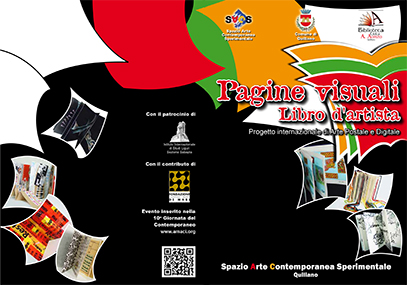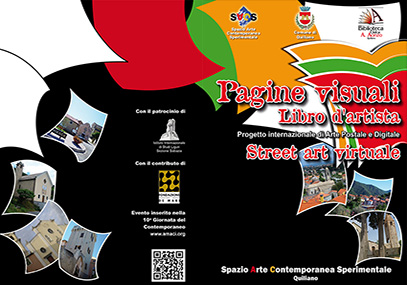 |
|
|---|---|
Video exhibition |
DOWNLOAD: Catalogue Visual page.pdf |
 |
|
| Video virtual Street art virtuale territory of Quiliano | DOWNLOAD: Virtual Ebook Street art epub - Virtual Street art .pdf |
IT |
EN |
|---|
 |
 |
|---|---|
Visual pages |
|
 |
|
|---|---|
Video exhibition |
DOWNLOAD: Catalogue Visual page.pdf |
 |
|
| Video virtual Street art virtuale territory of Quiliano | DOWNLOAD: Virtual Ebook Street art epub - Virtual Street art .pdf |
It was born from the inner layers of the plants’ bark, that were used as a framework for writing, but after
more than five centuries after the explosion of the “Gutenberg Galaxy”, whose mass was calculated ten
years ago in one hundred million units by the British Library, the book starts to lose its material configuration.
Computers, tablets and other electronic instruments, although still perfectible, have begun a
rising trend, that has the advantage of functionality. However, while the book may fear to be replaced
by more advanced systems in its educational function (as well as clay tablets were replaced by papyrus
and later by parchment), book over the centuries has become so deep-seated in cultural history and in
human imagination, to act as a metaphor for nature and for world. Perhaps by chance, or perhaps presaging
the decline of its use in ordinary communication, poets and artists have given the book a second
life, a life between expressivity and concern: sometimes they have enhanced its shape and its material
components, till they made a just aesthetic object of it, sometimes they have aimed for the reset of every
perceptual datum, to create an “empty book”, as it was already mentioned by Lichtenberg, a scientistwriter
of the eighteenth century. But this new existence of the book begins with “un acte de démence”, like
Mallarmé called “Un coup de dès”. It is a shocking experience, almost a Copernican revolution, in front
of which Valery did not hesitate to confess: “I felt as I saw the figure of a thought, which was fixed for the
first time in the space. Here it was the broaden speaking in truth, here it dreamed, here it produced forms,
that were born of the Time. Wait, doubt, meditation had become visible things. With the sense of sight I
touched body breaks of silence.” Hence a crescendo: from camouflages in Calligrammes of Apollinaire, to
explosive typographical tour de force in Marinetti’s Parole in libertà futuriste (Futurist Words in Freedom);
from the duets between words and images of Cendrars with Sonia Delaunay (La prose du Transsibérien)
and with Léger (La fin du monde filmée par l’Ange N.-D.) to constructivist design of El Lissitzky in Dlia
Golosa (For the voice) of Majakovskij. It is a crescendo that grows to the bolted book of Depero and to
Litolatta of Tullio D’Albisola and Bruno Munari; to detournés collages of Max Ernst in Une semaine de
bonté and the Boîte verte, where Duchamp collects the notes for the Large Glass to reach the lively silhouhettes,
cut by Matisse in Jazz…
But it is in the period after the Second World War that the artist’s book frees itself completely from the
remains which bound it often before to the sphere of illustration , to become a real work of art itself. Fetish
and object with its own aura, container for new alphabets (how can we forget, in this respect, Les journaux
des dieux of Isou?), exchanging object without end (Queneau), thematic catalogue of visual materials
(Ruscha), prototype of structural investigations (Gleber), made of only transparent pages (Manzoni) or of
instructions outside the diagram (Yoko Ono), the artist’s book became more and more, like mail art, a sort
of independent discipline, that is used everywhere with intensity, manipulating and combining with creativity
all contemporary languages. Or, if you want, the artist’s book represents nowadays an “alternative”
space, in which it is possible - as Ann Moeglin-Delcroix noted in her book “Esthètique du livre d’artiste
1960-1980” - for young and less young artists “to produce in a free way and to reach the public, outside
the official channels, that are more closed than ever since star system and financialization of art have
been dominating them”. It is a much more essential space today - as the French academic concludes -
“because the aim is not more, like at the beginning, to make art free from commoditization through the
book, but to resist its confiscation by stock market speculation”.